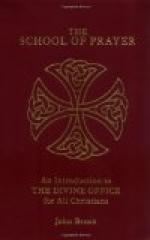“The preparation for Easter was the Lenten fasts. The fare on fast days consisted of water and soup made with flour; fruit and oil and bread were also eaten. The catechumens also fasted on Wednesdays and Fridays. Among the faithful there were some who ate nothing from their repast on Sunday until the following Saturday, e.g., for five days, and who all the year round took only one meal a day. Others abstained in Lent from all food for two consecutive days, but others fasted by taking nothing to eat all day, until the evening” (Kellner, op. cit., p. 93).
The Easter celebrations were in the early ages chiefly noted for the great and solemn ceremonies of baptism conferred on a large number of catechumens, with solemn procession from the baptistry to the cathedral. The Easter Octave celebrates by festivals the supper at Emmaus, the appearance of our Lord (St. Luke xxiv.), His appearance by the sea (St. John xxi. 1-14), His appearance to Magdalen (St. John xx. 11-18), His appearance on the mountain (St. Matthew xxviii. 16-20), and His appearance just after He had risen (St. John xx, 1-9),
THE ASCENSION.
This day was kept as a festival in very early times, although it is not mentioned in the lists of Church festivals given by Tertullian (+220), nor by Origen (185-254). St. Augustine (354-430) (Epist. ad Januarium, 54, c.l.) attributes the institution of this festival to an apostolic ordinance or the injunction of a general council. But neither can be proved. But the festival dates from the days of the early Church, and as it was natural that the concluding act of our Saviour’s life should be remembered and honoured, the celebration of the feast of His Ascension spread widely and rapidly. The feast was noted for the solemn processions held, to imitate and to commemorate our Lord’s leading of the Apostles out of the city to the Mount of Olives.
WHIT SUNDAY.
Pentecost or Whit Sunday extends back to the early days of the Church. From Tertullian, it is plain that the festival was well known and long established. In the Peregrinatio Silviae, we read a detailed account of how the feast was kept in Jerusalem at her visit (385-388). “On the night before Whitsunday the vigil was celebrated in the church of the Anastasis, at which the bishop, according to the usual custom in Jerusalem on Sundays, read the Gospel of the Resurrection, and the customary psalmody was performed. At dawn, all the people proceeded to the principal church (Martyrium) where a sermon was preached and Mass celebrated. About the third hour, when the psalmody was finished, the people singing accompanied the bishop to Sion. There, the passage from the Acts of the Apostles describing the descent of the Holy Ghost was read, and a second Mass was celebrated; after which the psalmody was resumed. Afterwards, the archdeacon invited the people to assemble




